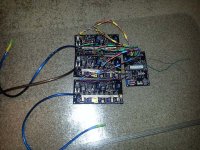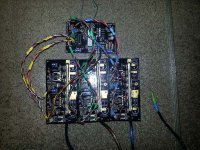This is how I do it as well. I think if you get the temp right it will flow into all the places it can the same way it would using an oven. I find this technique to work very well.Futterama said:When I'm soldering SMD components, which is the type I prefer, I apply a little solder to one of the pads, place the component, heat the solder and press the component down to the PCB. Now the component is fixed in the correct location, and I solder the other pads, starting in the opposite corner when doing IC's. The very first solder joint that fastened the component is reheated and applied the correct amount of solder.
When hand soldering SMD's, it's a good idea to make the PCB pads a bit larger than what is needed for reflow soldering, or at least the pad is a bit bigger than the SMD leg, so you have a bit of pad area to apply heat to when soldering.
A thing I have been wondering about, is whether the manually applied solder, when soldering SMD's by hand, gets in between the SMD leg and the PCB pad, or the solder just wraps around on the outside of the leg, creating an inferior connection.
I just got a set of tweezers and the biggest thing that helps is getting a pad soldered and ready.
You should also go over all pads with a flux pen.



